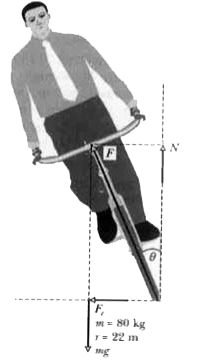A boy climbs up a hill, which rises 1 in every 25, on his bicycle. The mass of the boy and his bicycle is 120 kg. What is the power applied by the body if he is cycling at the rate of 6 km/h hour? (Assume the friction is absent and g=10m/s2)
80 watt
70 watt
100 watt
120 watt
The correct Answer is:A
Power =WorkTime=Force×DisplacementTime
=Fdxdt=Fv= Force × velocity
Topper's Solved these Questions
Similar Questions
A boy is cycling with a speed of 10 km h−1 on a hill of slope 1/20 . The weight of the boy and the cycle is 120 kg . Calculate the work done by the man per minute . Also find his horse power .
View SolutionA man cycles up a hill whose slope is 1 in 20 with a velocity of 6.4kmh−1 along the hill. The weight of the man and the cycle is 98kg. What work per minute is the man doing ? What is his horse power ?
View Solution
Knowledge Check
A boy lifts a mass of 1 kg to a height of I m in 20 sec. The power of the boy is (Take g=10m/s2)
A0.1 W,B0.2 WC0.25 W,D0.5 W.A man cycles up a hill rising 1 metre vertically for every 50 metres along the slope. Find the power of the man, if he cycles up at the rate of 3.6 km/ hr. The weight of the cycle and man is equal to 120kg. Neglect force of friction.
A32.25 wattB23.52 wattC25.32 wattD52.32 wattA man cycling up a smooth inclne road, climbs the road at a constant spped of 2m/s. The total mass of the man and the cycle is 150 kg and the inclination of the road with the horizonal is 30∘. What is the minimum horse power spend by the man?
[Take g=10m/s2 and 1 horse power =750 watt]A1.25H.PB1.5H.PC2H.PD5H.P
A boy on a bicycle pedals around a circle of 22 m radius at a speed of 10m/s. The combined mass of the boy and the bicycle combined mass of the boy and the bicycle is 80 kg. (a) What is the centripetal force exerted by the pavement on the bicycle? (b) What is the upward force exerted by the pavement on the bicycle? See fig.

View SolutionThe work done by a boy in lifting his bag up to a height of 2 m is 200 J . Find the mass of his bag
(Take g = 10 ms−2).
View SolutionCalculate the power of an engine which can pull a train of mass 25000 quintal up an incline of 1 in 100 at the rate of 10.8km/h Resistance due to friction is 2N/guintal.
View SolutionThe work done by a boy in lifting his bag up to a height of 2 m is 200 J . Find the mass of his bag
(Take g = 10 ms−2).
View SolutionWhat is the smallest radius of a curve on a horizontal road , at which a cyslist can travel if his speed is 36 km / hour and the angle of inclination is 45∘ ?(g =10m/s2)
View Solution
